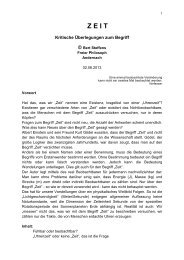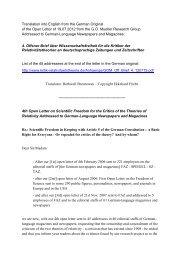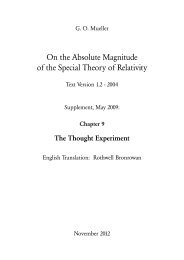2394 weitere kritische Veröffentlichungen - Kritische Stimmen zur ...
2394 weitere kritische Veröffentlichungen - Kritische Stimmen zur ...
2394 weitere kritische Veröffentlichungen - Kritische Stimmen zur ...
Erfolgreiche ePaper selbst erstellen
Machen Sie aus Ihren PDF Publikationen ein blätterbares Flipbook mit unserer einzigartigen Google optimierten e-Paper Software.
this theory are treated as postulates or as direct consequences<br />
of the postulates. However, the special relativity<br />
is based on some experimental facts which cannot be<br />
derived from the postulates of the theory. The subject<br />
of this article is the analysis of the consistency of the<br />
relativistic transformations of the potentials with the<br />
experimental facts.<br />
Development of the classical electrodynamics at the<br />
end of XIX and beginning of XX century went in a way<br />
when the main attention was focused on seeking the<br />
transformations for the EM field while going from a<br />
frame at a rest to the moving frame. However, the expressions<br />
for transformed EM fields have not been<br />
studied with necessary thoroughness, namely, only the<br />
expressions for the fields created by single point charge<br />
were analyzed. But even while analysing these simple<br />
expressions some points are overlooked; by the way,<br />
these points form the basis of the special relativity. We<br />
will show that these 'holes' in basement of the special<br />
relativity make the latter to be incorrect. We start from<br />
well known Lorentz transformations."<br />
"In conclusion, we obtain that the only relativistically<br />
correct method of establishing the connection between<br />
the LW [= Liénard-Wiechert] and Coulomb potentials<br />
is relativistically non-invariant itself. Therefore, the<br />
relativistic connection (2b) between these potentials<br />
derived by Lorentz looks like an artefact, which is conditioned<br />
by applying the point like approximation (29b)<br />
of the elementary charge. But if we consider the connection<br />
between the LW and Coulomb potentials in a<br />
strictly mathematical way, and at very small distance,<br />
we obtain that Eq. (2b) is wrong. Therefore, the scalar<br />
potential cannot be treated as the zero-component of a<br />
relativistic four-vector."<br />
Anmerkung 4: "It is the main trouble of the special<br />
relativity that it is impossible to compare quantities<br />
which belong to different frames."<br />
Orman, Mort 2010<br />
How Einstein arrived at E=mc² / Mort Orman. - [Land?]:<br />
WWW 2010. 5 S.<br />
URL: http://www.stresscure.com/hrn/einstein.html<br />
Status: Kritik. - Quelle: Autopsie.<br />
Ortiz Fornaguera, Ramon 1964<br />
Sobre una nueva teoría de la relatividad / Ramon<br />
Ortiz Fornaguera.<br />
In: Academia de ciencias exactas, fisicas y naturales<br />
de Madrid. Revista. 58. 1964, p. 399-415.<br />
Status: Kandidat. - Quelle: Soler Ferran 2009 (Teoria).<br />
Ortiz Fornaguera, Ramon 1965<br />
Comentarios a dos recientes artículos de J. Palacios<br />
/ Ramon Ortiz Fornaguera.<br />
In: Academia de ciencias exactas, fisicas y natu-<br />
rales de Madrid. Revista. 59. 1965, p. 439-446.<br />
Status: Kandidat. - Quelle: Soler Ferran 2009 (Teoria).<br />
Osmaston, Miles F. 2006 ca.<br />
A continuum theory (CT) of physical nature: towards a<br />
new 'ground floor' for physics and astronomy, including<br />
gravitation and cosmogony, with major tangible support<br />
/ Miles F. Osmaston. - [UK]: WWW 2006 ca.. 41 S.<br />
URL: http://www.physicsfoundations.org/PIRT/<br />
PIRT_X/papers/OSMASTON%20PAPER%202006.pdf<br />
Status: Kritik. - Quelle: Autopsie.<br />
Ovtchinnikov, N. F. 1960<br />
Die Erörterung der philosophischen Fragen der Relativitätstheorie<br />
/ N. F. Owtschinnikow.<br />
In: Fuer einen neuen Aufschwung von Naturwissenschaft<br />
und Philosophie. Berlin (Ost) 1960, S. 48-<br />
61.<br />
SRT. IS. RP. ART. GRAVIT. ERK. UdSSR. MARX.<br />
Berichtet über Vorträge und Diskussionen <strong>zur</strong> Relativitätstheorie<br />
auf der "Allunionskonferenz der UdSSR zu<br />
den philosophischen Fragen der modernen Naturwissenschaft"<br />
(Moskau, 21.-25.10.1958). Die Zitate sind<br />
Texte von Ovtchinnikov; Ovtchinnikovs Zitate aus den<br />
Konferenzvorträgen sind durch die Anfangsbuchstaben<br />
der behandelten Autoren gekennzeichnet .<br />
S. 48-49: "Die Frage nach der Abhängigkeit der<br />
Masse, der Länge und der Zeit von der Bewegungsgeschwindigkeit<br />
der Körper und die Frage nach dem<br />
Zusammenhang von Energie und Masse" seien zwar<br />
schon vor 50 Jahren aufgetreten und diskutiert worden,<br />
dürften aber nicht als "veraltete 'rückwärtige' Probleme"<br />
von der Diskussion ausgeschlossen werden, sondern<br />
gehörten notwendig zu einer Analyse der philosophischen<br />
Probleme der Theorie und <strong>zur</strong> Entwicklung<br />
einer "richtigen wissenschaftlichen Denkmethode". Es<br />
"sind alte und gleichzeitig auch ewig neue Fragen, die<br />
stets aufs neue erörtert werden müssen". - S. 51: Hält<br />
es für "grundsätzlich verkehrt", den logischen Aufbau<br />
einer Theorie nur deshalb nicht zu analysieren, weil<br />
"diese Theorie vor vielen Jahrzehnten aufgestellt wurde."<br />
S. 51-55: Vortrag von A. D. Alexandrow und Diskussion.<br />
Einerseits unterstreicht A. "den unvergänglichen<br />
Wert der Resultate der Relativitätstheorie", andererseits<br />
muß man aber auch "Kritik üben" an den "philosophischen<br />
Voraussetzungen" und den "philosophischen<br />
Schlußfolgerungen" der Theorie und "in gewissem<br />
Sinne auch an dem physikalischen Inhalt der Theorie".<br />
A. befürwortet eine Umgestaltung der Theorie;<br />
"der Aufbau der Theorie selbst und die Auffassung<br />
ihres Wesens" müssen anders erfolgen; die Logik des<br />
Aufbaus der Theorie muß (A.) "in gewissem Sinne der<br />
Einsteinschen gerade entgegengesetzt" sein. A. will die<br />
Theorie nicht von Wechselwirkungszusammenhängen,<br />
sondern von den raum-zeitlichen Verhältnissen aufbauen.<br />
Textversion 1.2 - 2012 243<br />
G. O. Mueller: SRT Kap. 4-Erg..





